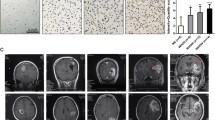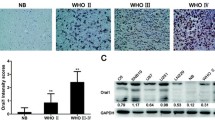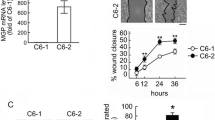Abstract
Invasion of glioblastoma cells significantly reduces the effectiveness of current treatments, highlighting the importance of understanding dispersal mechanisms and characteristics of the invasive population. Induction of calcium fluxes into glioblastoma cells by autocrine glutamate is critical for invasion. However, the target(s) by which calcium acts to stimulate the dispersal of glioblastoma cells is not clear. In this study, we tested the hypothesis that the calcium-activated protease calpain 2 is required for glioblastoma cell invasion. Knockdown of calpain 2 expression using shRNA or chemical inhibition of calpain activity reduced glioblastoma cell invasion by 90%. Interestingly, decreased expression of calpain 2 did not influence morphology or migration, suggesting regulation of invasion specific mechanisms. Consistent with this idea, 39% less extracellular MMP2 was measured from knockdown cells identifying one mechanism by which calpain 2 mediates glioblastoma cell invasion. This is the first report demonstrating that calpain 2 is required for glioblastoma cell invasion.










Similar content being viewed by others
Abbreviations
- AMPA:
-
α-amino-3-hydroxyl-5-methyl-4-isoxazole-propionate
- CL:
-
Collagen type IV
- DMEM:
-
Dulbecco’s modified Eagle media
- FBS:
-
Fetal bovine serum
- FN:
-
Fibronectin
- LN:
-
Laminin
References
Bhatt A, Kaverina I, Otey C, Huttenlocher A (2002) Regulation of focal complex composition and disassembly by the calcium-dependent protease calpain. J Cell Sci 115:3415–3425
Braun C, Engel M, Seifert M, Theisinger B, Seitz G, Zang KD, Welter C (1999) Expression of calpain I messenger RNA in human renal cell carcinoma: correlation with lymph node metastasis and histological type. Int J Cancer 84:6–9
Buccione R, Caldieri G, Ayala I (2009) Invadopodia: specialized tumor cell structures for the focal degradation of the extracellular matrix. Cancer Metastasis Rev 28:137–149
Carragher NO, Fonseca BD, Frame MC (2004) Calpain activity is generally elevated during transformation but has oncogene-specific biological functions. Neoplasia 6:53–73
CBTRUS (2005) Statistical report: primary brain tumors in the United States, 199–2002. Published by the Central Brain Tumor Registry of the United States
Cortesio CL, Chan KT, Perrin BJ, Burton NO, Zhang S, Zhang ZY, Huttenlocher A (2008) Calpain 2 and PTP1B function in a novel pathway with Src to regulate invadopodia dynamics and breast cancer cell invasion. J Cell Biol 180:957–971
Dourdin N, Bhatt AK, Dutt P, Greer PA, Arthur JS, Elce JS, Huttenlocher A (2001) Reduced cell migration and disruption of the actin cytoskeleton in calpain-deficient embryonic fibroblasts. J Biol Chem 276:48382–48388
Franco S, Perrin B, Huttenlocher A (2004) Isoform specific function of calpain 2 in regulating membrane protrusion. Exp Cell Res 299:179–187
Franco SJ, Rodgers MA, Perrin BJ, Han J, Bennin DA, Critchley DR, Huttenlocher A (2004) Calpain-mediated proteolysis of talin regulates adhesion dynamics. Nat Cell Biol 6:977–983
Giannone G, Ronde P, Gaire M, Haiech J, Takeda K (2002) Calcium oscillations trigger focal adhesion disassembly in human U87 astrocytoma cells. J Biol Chem 277:26364–26371
Gimona M, Buccione R, Courtneidge SA, Linder S (2008) Assembly and biological role of podosomes and invadopodia. Curr Opin Cell Biol 20:235–241
Glading A, Chang P, Lauffenburger DA, Wells A (2000) Epidermal growth factor receptor activation of calpain is required for fibroblast motility and occurs via an ERK/MAP kinase signaling pathway. J Biol Chem 275:2390–2398
Goldberg L, Kloog Y (2006) A Ras inhibitor tilts the balance between Rac and Rho and blocks phosphatidylinositol 3-kinase-dependent glioblastoma cell migration. Cancer Res 66:11709–11717
Goll DE, Thompson VF, Li H, Wei W, Cong J (2003) The calpain system. Physiol Rev 83:731–801
Gorlin JB, Yamin R, Egan S, Stewart M, Stossel TP, Kwiatkowski DJ, Hartwig JH (1990) Human endothelial actin-binding protein (ABP-280, nonmuscle filamin): a molecular leaf spring. J Cell Biol 111:1089–1105
Gu J, Tamura M, Pankov R, Danen EH, Takino T, Matsumoto K, Yamada KM (1999) Shc and FAK differentially regulate cell motility and directionality modulated by PTEN. J Cell Biol 146:389–403
Huber E, Vlasny D, Jeckel S, Stubenrauch F, Iftner T (2004) Gene profiling of cottontail rabbit papillomavirus-induced carcinomas identifies upregulated genes directly Involved in stroma invasion as shown by small interfering RNA-mediated gene silencing. J Virol 78:7478–7489
Huttenlocher A, Palecek SP, Lu Q, Zhang W, Mellgren RL, Lauffenburger DA, Ginsberg MH, Horwitz AF (1997) Regulation of cell migration by the calcium-dependent protease calpain. J Biol Chem 272:32719–32722
Ishiuchi S, Tsuzuki K, Yoshida Y, Yamada N, Hagimura N, Okado H, Miwa A, Kurihara H, Nakazato Y, Tamura M, Sasaki T, Ozawa S (2002) Blockage of Ca(2 +)-permeable AMPA receptors suppresses migration and induces apoptosis in human glioblastoma cells. Nat Med 8:971–978
Kimura Y, Koga H, Araki N, Mugita N, Fujita N, Takeshima H, Nishi T, Yamashima T, Saido TC, Yamasaki T, Moritake K, Saya H, Nakao M (1998) The involvement of calpain-dependent proteolysis of the tumor suppressor NF2 (merlin) in schwannomas and meningiomas. Nat Med 4:915–922
Kleinman HK, Martin GR (2005) Matrigel: basement membrane matrix with biological activity. Semin Cancer Biol 15:378–386
Kubiatowski T, Jang T, Lachyankar MB, Salmonsen R, Nabi RR, Quesenberry PJ, Litofsky NS, Ross AH, Recht LD (2001) Association of increased phosphatidylinositol 3-kinase signaling with increased invasiveness and gelatinase activity in malignant gliomas. J Neurosurg 95:480–488
Lakshmikuttyamma A, Selvakumar P, Kanthan R, Kanthan SC, Sharma RK (2004) Overexpression of m-calpain in human colorectal adenocarcinomas. Cancer Epidemiol Biomarkers Prev 13:1604–1609
Li J, Yen C, Liaw D, Podsypanina K, Bose S, Wang SI, Puc J, Miliaresis C, Rodgers L, McCombie R, Bigner SH, Giovanella BC, Ittmann M, Tycko B, Hibshoosh H, Wigler MH, Parsons R (1997) PTEN, a putative protein tyrosine phosphatase gene mutated in human brain, breast, and prostate cancer. Science 275:1943–1947
Libertini SJ, Robinson BS, Dhillon NK, Glick D, George M, Dandekar S, Gregg JP, Sawai E, Mudryj M (2005) Cyclin E both regulates and is regulated by calpain 2, a protease associated with metastatic breast cancer phenotype. Cancer Res 65:10700–10708
Liu GJ, Nagarajah R, Banati RB, Bennett MR (2009) Glutamate induces directed chemotaxis of microglia. Eur J Neurosci 29:1108–1118
Lyons SA, Chung WJ, Weaver AK, Ogunrinu T, Sontheimer H (2007) Autocrine glutamate signaling promotes glioma cell invasion. Cancer Res 67:9463–9471
Mamoune A, Luo JH, Lauffenburger DA, Wells A (2003) Calpain-2 as a target for limiting prostate cancer invasion. Cancer Res 63:4632–4640
Nuzzi PA, Senetar MA, Huttenlocher A (2007) Asymmetric localization of Calpain 2 during neutrophil chemotaxis. Mol Biol Cell 18:795–805
Palecek SP, Huttenlocher A, Horwitz AF, Lauffenburger DA (1998) Physical and biochemical regulation of integrin release during rear detachment of migrating cells. J Cell Sci 111:929–940
Perrin BJ, Amann KJ, Huttenlocher A (2006) Proteolysis of cortactin by calpain regulates membrane protrusion during cell migration. Mol Biol Cell 17:239–250
Postovit LM, Dutt P, Dourdin N, Park M, Greer PA, Graham CH, Elce JS (2002) Calpain is required for MMP-2 and u-PA expression in SV40 large T-antigen-immortalized cells. Biochem Biophys Res Commun 297:294–301
Potter DA, Tirnauer JS, Janssen R, Croall DE, Hughes CN, Fiacco KA, Mier JW, Maki M, Herman IM (1998) Calpain regulates actin remodeling during cell spreading. J Cell Biol 141:647–662
Rios-Doria J, Day KC, Kuefer R, Rashid MG, Chinnaiyan AM, Rubin MA, Day ML (2003) The role of calpain in the proteolytic cleavage of E-cadherin in prostate and mammary epithelial cells. J Biol Chem 278:1372–1379
Rios-Doria J, Kuefer R, Ethier SP, Day ML (2004) Cleavage of beta-catenin by calpain in prostate and mammary tumor cells. Cancer Res 64:7237–7240
Samuels Y, Wang Z, Bardelli A, Silliman N, Ptak J, Szabo S, Yan H, Gazdar A, Powell SM, Riggins GJ, Willson JK, Markowitz S, Kinzler KW, Vogelstein B, Velculescu VE (2004) High frequency of mutations of the PIK3CA gene in human cancers. Science 304:554
Shiba E, Kambayashi JI, Sakon M, Kawasaki T, Kobayashi T, Koyama H, Yayoi E, Takatsuka Y, Takai SI (1996) Ca2+-dependent neutral protease (Calpain) activity in breast cancer tissue and estrogen receptor status. Breast Cancer 3:13–17
Shiraha H, Glading A, Gupta K, Wells A (1999) IP-10 inhibits epidermal growth factor-induced motility by decreasing epidermal growth factor receptor-mediated calpain activity. J Cell Biol 146:243–254
Sontheimer H (2008) A role for glutamate in growth and invasion of primary brain tumors. J Neurochem 105:287–295
Sprague CR, Fraley TS, Jang HS, Lal S, Greenwood JA (2008) Phosphoinositide binding to the substrate regulates susceptibility to proteolysis by calpain. J Biol Chem 283(14):9217–9223
Stylli SS, Kaye AH, Lock P (2008) Invadopodia: at the cutting edge of tumour invasion. J Clin Neurosci 15:725–737
Tamura M, Gu J, Takino T, Yamada KM (1999) Tumor suppressor PTEN inhibition of cell invasion, migration, and growth: differential involvement of focal adhesion kinase and p130Cas. Cancer Res 59:442–449
Troeberg L, Nagase H (2003) Zymography of metalloproteinases. Curr Protoc Protein Sci Suppl 33:21.15.1–21.15.12
Weaver AM (2006) Invadopodia: specialized cell structures for cancer invasion. Clin Exp Metastasis 23:97–105
Ye ZC, Sontheimer H (1999) Glioma cells release excitotoxic concentrations of glutamate. Cancer Res 59:4383–4391
Acknowledgments
This work was supported by grants to J.A.G. from the Medical Research Foundation of Oregon, the General Research Fund of Oregon State University, and GM 63711 from the National Institute of General Medical Sciences, National Institutes of Health. This publication was made possible in part by the Cell Imaging and Analysis Facility and Services Core of the Environmental Health Sciences Center at Oregon State University from grant P30 ES00210, National Institute of Environmental Health Sciences, National Institutes of Health. Special thanks to Tamara S. Fraley for expert assistance with tissue culture and microscopy.
Author information
Authors and Affiliations
Corresponding author
Additional information
Submitted in partial fulfillment of the requirements for the degree of Doctor of Philosophy in the Graduate School of Oregon State University.
Rights and permissions
About this article
Cite this article
Jang, H.S., Lal, S. & Greenwood, J.A. Calpain 2 is Required for Glioblastoma Cell Invasion: Regulation of Matrix Metalloproteinase 2. Neurochem Res 35, 1796–1804 (2010). https://doi.org/10.1007/s11064-010-0246-8
Accepted:
Published:
Issue Date:
DOI: https://doi.org/10.1007/s11064-010-0246-8




